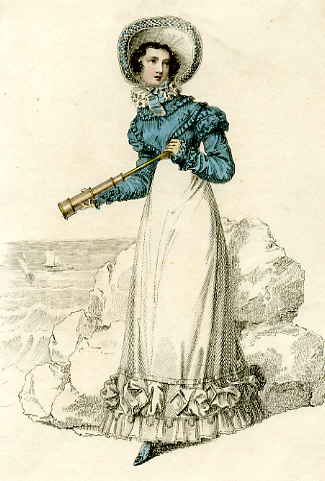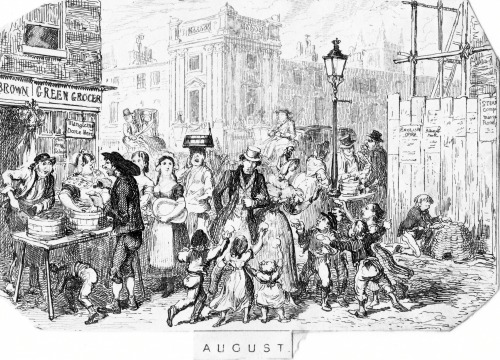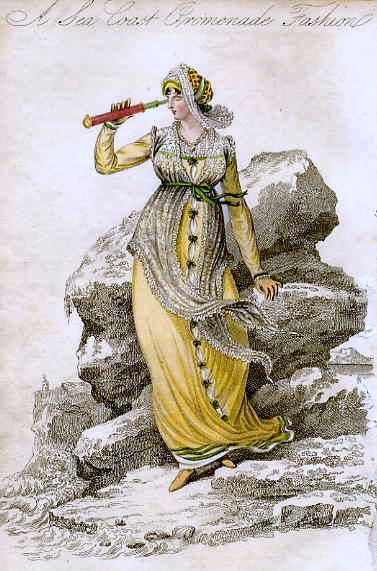The new adaptation of Jane Austen’s Sanditon is all the rage on British TV as I write this post, so here is a collection of fashionable outfits to help you decide what to wear to the seaside. First of all, remember to pack your telescope (or you can hire one from most circulating libraries.) A lady never knows when she might need to check that the gentlemen are sticking to their allocated section of beach.
 The image above is from La Belle Assemblée for October 1809 and shows ‘Sea Coast Promenade Fashion.’
The image above is from La Belle Assemblée for October 1809 and shows ‘Sea Coast Promenade Fashion.’
 Somewhat later – I do not have a date for this, but it is c1820 – is this ‘Walking Dress’ from Ackermann’s Repository. I can’t help feeling that this lady is looking positively shifty as she readies her telescope.
Somewhat later – I do not have a date for this, but it is c1820 – is this ‘Walking Dress’ from Ackermann’s Repository. I can’t help feeling that this lady is looking positively shifty as she readies her telescope.
Also in October 1809 the same periodical showed, ‘Bathing Place Assembly Ball Dress’ (below), illustrated with the neat trick of having a mirror at the back. I can’t help feeling that the head and the bosom are slightly out of proportion… It is interesting that both are published in October – surely far too late for the seaside ‘Season’.

If you feel daring you might like to try one of Mrs Bell’s more… interesting (?) confections….

This extraordinary garment (La Belle Assemblée September 1810) is described as ‘Bathing Place Evening Dress’ and looks like nothing more than some form of night-wear with its buttons right down the front and the display of the shocking pantalettes.
Walking dresses for the seaside show a complete disregard for sea breezes, with bonnets and parasols deployed by every lady. These ladies on the beach at Southend seem to be hanging on to skirts and parasols with some difficulty.

This lady, walking her dog on the beach with bathing machines behind her, seems positively agitated as she clings to her hat with her shawl whipping around her. This is a plate from Ackermann’s Repository August 1822.
A rather more tranquil day is shown here in another dog-walking scene, although I would not like to be her lady’s maid, trying to get salt water and sand out of those trailing skirts!

 What did one wear to get to and from those bathing machines? The ever-inventive Mrs Bell produced a magnificent ‘Sea Side Bathing Dress’ for the August 1815 edition of La Belle Assemblée. This is not the costume for entering the sea but for wearing to get there, and it is lavishly trimmed in drooping green, presumably to imitate seaweed. Note the bag she is carrying. This contains Mrs Bell’s ‘Bathing Preserver’ which she produced in 1814. You can see it in its bag again below (La Belle Assemblée September 1814). Here the lady is wearing ‘Sea Side Morning Dress’ with ‘Bathing Preserver. Invented & to be had exclusively of Mrs Bell, No.26 Charlotte Street, Bedford Square.’ The Preserver is in the bag lying beside her chair.
What did one wear to get to and from those bathing machines? The ever-inventive Mrs Bell produced a magnificent ‘Sea Side Bathing Dress’ for the August 1815 edition of La Belle Assemblée. This is not the costume for entering the sea but for wearing to get there, and it is lavishly trimmed in drooping green, presumably to imitate seaweed. Note the bag she is carrying. This contains Mrs Bell’s ‘Bathing Preserver’ which she produced in 1814. You can see it in its bag again below (La Belle Assemblée September 1814). Here the lady is wearing ‘Sea Side Morning Dress’ with ‘Bathing Preserver. Invented & to be had exclusively of Mrs Bell, No.26 Charlotte Street, Bedford Square.’ The Preserver is in the bag lying beside her chair.

Ladies normally wore a simple flannel garment with head and arm holes and possibly a weighted hem – ‘a flannel case’. One could provide one’s own or hire one, and this is what Mrs Bell is referring to in her description of the Perserver:
‘The Bathing Preserver‘ is a most ingenious and useful novelty for ladies who frequent the sea-side; as it is intended to provide them with a dress for bathing far more adapted to such purposes than anything of the kind at present in use; and it will be found most necessary and desirable to those ladies who go to the sea-side unprovided with bathing dresses and will relieve them from the nauseous idea of wearing the bathing coverings furnished by the guides [the ‘dippers’ or bathing-women]. Mrs Bell’s Bathing Preserver is made in quite a novel manner to which is attached a cap to be removed at pleasure, made of a delicate silk to keep the head dry. The Preserver is made of such light material that a lady may carry it in a tasteful oiled silk bag of the same size as an ordinary lady’s reticule.’
Discover all about the Georgian seaside, from bathing dresses to royal patronage, in The Georgian Seaside: The English resorts before the railway age.





